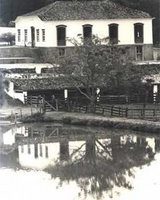History
 The origin of the Mangalarga Marchador dates back to 1807, when Emperor Pedro I of Brazil (or IV of Portugal) migrated to Brazil due to Napoleon’s invasion to Portugal. Pedro I was the one who proclaimed Brazil Independiente de Portugal and became the First Emperor of Brazil. In his move to Brazil he brough with him and his court the best horses of the Royal Cavalry. At his return to Portugal some years later, he presents Gabriel Francisco Junqueira (known as the Baron of Alfenas), with an oustanding and famous stallion called: “Sublime”. Junqueira was a deputy of the Imperial Court and owner of the Hacienda Campo Alegre in the south of Minas Gerais.
The origin of the Mangalarga Marchador dates back to 1807, when Emperor Pedro I of Brazil (or IV of Portugal) migrated to Brazil due to Napoleon’s invasion to Portugal. Pedro I was the one who proclaimed Brazil Independiente de Portugal and became the First Emperor of Brazil. In his move to Brazil he brough with him and his court the best horses of the Royal Cavalry. At his return to Portugal some years later, he presents Gabriel Francisco Junqueira (known as the Baron of Alfenas), with an oustanding and famous stallion called: “Sublime”. Junqueira was a deputy of the Imperial Court and owner of the Hacienda Campo Alegre in the south of Minas Gerais.
Sublime descended from the Alter Real breed from Portugal. “Alter” refers to the town of Alter do Chão and the word “Real” refers to royalty. The Alter Real is an Iberian breed closely related to the Lusitano and Andaluses horses.
In Brazil of that time there were mares with Berber and Jennet bloodlines brought by the settlers. The Berber is one of the oldest race in the world, originating in the countries of the Maghreb in North Africa (Mauritania, Morocco, Algeria, Tunisia and Libya). Berber were an ambling breed. Since ancient times the breed has been domesticated and trained for hunting, war, parade and work, being a common companion of nomads and shepherds in the territories of North Africa. Roman writings with more than 2,000 years of antiquity already spoke of them like horses of Berberia. This breed was introduced by the Moors in Spain where they crossed with local horses giving origin to the Spanish Jennet. The Jennet was a gaited/ambling horse. Now nearly extint, it provided the basis for most European and American breeds.
From the cross between the Royal Alter and the local Brazilian mares (who had Berber and Jennet bloods) comes the Mangalarga Marchador. Gabriel Francisco Junqueira through genetic selection began developing a breed that was notable for its gait (very confortable), their resistant and their docile and active attitued.
There are several versions on the origin of the name Mangalarga Marchador. According to the most widespread , the word Mangalarga comes from the Hacienda Mangalarga located in Pati do Alferes in the State of Rio De Janeiro. The owners of this hacienda bought their horses from the South of Minas Gerais, among which there were some descendants of the early Mangalarga Marchadores. In Rio de Janeiro, the horses began to attract the attention because of their smooth gait, beauty and presence. The question that arose was “Whose horses were they?” And the answer was “Hacienda Mangalarga.”
At the beginning of the 20th century members of the Junqueria family moved to the State of São Paulo and brought with them some Marchadores. With the purpose of adapting the horses to a new topography and deer hunting, they cross them with other breeds like English Thoroughbred, Arabian and American Saddlebred, giving rise to the Mangalarga Paulista.
At the same time, in the South of Minas, the breed consolidated through a careful selection of animals, looking for a gentle ride and resistance to long horseback riding on the large estates. In addition to Campo Alegre, other haciendas such as Campo Lindo, Traituba, Favacho, Engenho da Serra and Angahy arose as pillars of the breed. Since then and for more than 200 years the Marchadores descendants of these Haciendas have developed without any crossbreeding with other breeds.
In early 1949 the breeders came together to create an association, known today as the Brazilian Association of Breeders of Mangalarga Marchador Horses (ABCCMM). The Association is located in Belo Horizonte with the main objective of establishing breed standards and promoting their dissemination. The ABCCMM has more than 7,000 members and about 190,000 registered horses. The breed has spread throughout Brazil and incipiently in the World. Uruguay is the first country in Latin America (other than Brasil) to breed Mangalarga Machador.
The following video illustrates the story of the MM, enjoy it !!
